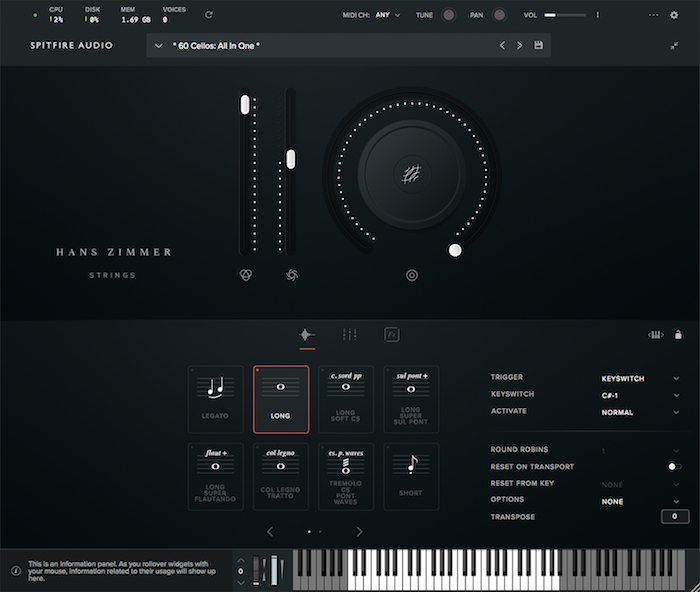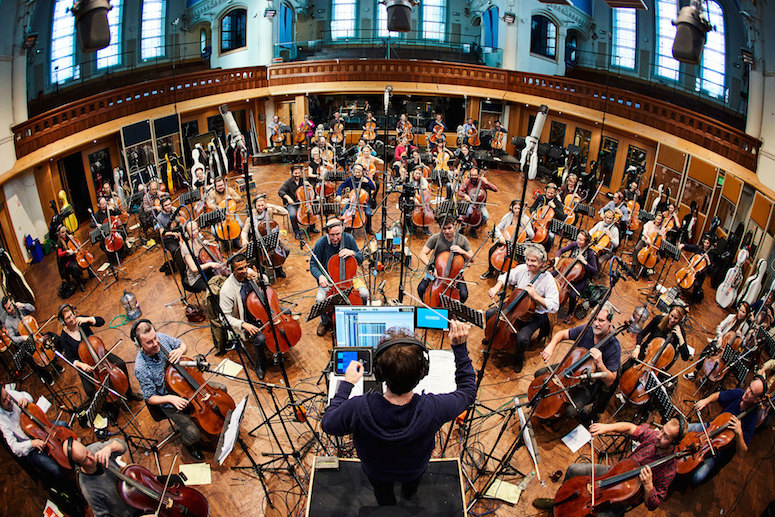New Software Review: Hans Zimmer Strings by Spitfire Audio

In creating Hans Zimmer Strings, Spitfire Audio painstakingly sampled an astonishing 344 players at the famed AIR Studios’ Lyndhurst Hall in the UK.
Back in March, I live-streamed Spitfire Audio‘s announcement of a brand new product.
I was quite excited to hear about the news as it became public as practically all the Spitfire releases lately have been inspiring ones, innovative in ways that have set them apart from the offerings by most other sample library developers.
Much of this comes from Spitfire’s unique approach to sampling, which simply consists of getting a great player in a great sounding room with a great recording engineer.
This approach—coupled with world-renowned composer Hans Zimmer’s dedication to creating his own samples—has produced amazing results in the past, from Hans Zimmer Percussion 2 (which features legendary drummer Jason Bonham), to the newly-revamped Hans Zimmer Percussion and Hans Zimmer Percussion Professional,
With these first offerings, Zimmer and Spitfire have already offered the world a palette of sounds that has helped define modern cinematic music, so it was quite a pleasant surprise that during this live-streamed announcement, Hans Zimmer Strings was announced to the world. I was eager to get my hands on it for a review.
Features
HZ Strings isn’t meant to be the be-all and end-all string library for every composer. In some ways, it’s not even an attempt to capture the “Hans Zimmer strings” sound. Instead, this collaboration is an attempt at something that’s never been done before: Capturing a massive 344-piece string band at AIR Studios’ Lyndhurst Hall in the UK.
This is also Spitfire Audio’s first dedicated plugin sample library available in AU/AAX/VST2/VST3 format, as all of their former libraries (with the exception of BT Phobos) are made to run within Native Instruments’ Kontakt interface.
HZ Strings’ sleek black interface is easy to navigate and should feel comfortable for users of any Spitfire strings libraries. The main controls consist of two faders: One for volume/expression and another for adjusting dynamics. There’s one big knob that can be assigned to Reverb, Release, Tightness, or Vibrato, and below that are 3 selectable menus to switch between the Signal Mixer, Technique Switcher, and FX.
Before explaining the preset selector, I should clarify that Spitfire did not record all 344 string players at the same time; they recorded 140 violins, 140 cellos, 40 violas, and 24 basses in different sections, placed in different parts of the studio.
For instance, with the violins, you have access to presets such as 60 Full Violin, 20 Left, 20 Right, 20 Center, and 20 Galleries. It’s really quite nice for placing the players all across the studio and stereo spectrum, and the Galleries presets are great for adding space to your strings!
Do note that the cellos have the same configuration of presets as the violins, but the violas were only recorded in center and wide configurations, and the basses were recorded just in center. (This is logical, as you typically wouldn’t need to have your basses coming from left, right, or above in the galleries in most cases.)
In Use
I should start by saying that for this review, I am running HZ Strings on a relatively new, late-2017 MacBook Pro with 16GB of RAM, and using a 2TB solid state drive to house the samples. I’m also running HZ Strings in both Ableton Live and Logic Pro X. Weighing in at a massive 183GB (compressed), this is a pretty sizable instrument and will take a while to download and install. I would recommend running it off of a solid state drive, if you can.
With the initial launch of the plugin, I was impressed by the default preset of a 60 Cello ensemble, which produced big silky textures. It’s not the type of sound I’m accustomed to (I don’t normally have the budget to hire 60 cellists for my sessions), but I can imagine myself finding use for the basic “Init” preset in the near future to add some silky warmth to my demos and mockups.
Many composers I know stack a couple of different string libraries on top of one another to create the sense of a “bigger” orchestra, and I’m sure HZ Strings will excel as a layering tool for this.
There is a wide variety of available articulations for all of the string groups, and you can find the whole list here on the Spitfire website. Since these go so deep, there’s no way to cover them all; instead, I’d like to highlight my favorite unique articulations, and shine light on a couple that I wish they would add or refine in future updates.

Although not all 344 players were sampled at the same time, the result is a near-limitless wealth of options within Hans Zimmer Strings for you to craft nearly any string sound imaginable.
The beauty in this product comes from having many players play as quietly as possible, thus creating textures that can feel truly magical.
My favorite sound in the library is the 60 Cello patch “Tremolo CS Pont Waves”, where a tremolo was conducted across the room, left to right and back again, producing a wave-like effect. The only other offering in the sample world for this that I can think of is Spitfire’s Albion V Tundra library, which focuses on getting many players into a studio and having them play as softly as possible to create some complex textures.
The “Col Legno Tratto” presets are also remarkable, as the players use the back of the bow to play the strings. Normally, this type of playing style would be too quiet with a small section, but with 60 cellos or 60 violins all playing together, it creates a very intricate pad of sound.
I should note that some of these “soft” patches are much quieter than the provided normal “long” patches—it seems strange that Spitfire didn’t make these louder. In one of the official Spitfire HZ Strings YouTube demos, I even noticed that the demonstrator had to raise the output faders in Logic to +6dB in order to make them audible with the rest of the instruments in the demo.
One feature I found to be very useful is that under the Options menu, you can layer round robins to get a wider sound out of this library. For those who aren’t familiar with round robins, they are a way to ensure that repeated notes don’t sound robotic and unnatural.
Because Spitfire recorded the same note multiple times, the plugin cycles through them upon repeat—so if you play multiple C3s in succession, you aren’t always hearing the same exact sample. This provides valuable variation in the sound, and when layering round robins, you could essentially get up to 120 cellos or violins while playing one note!
To Be Critical
I think Spitfire Audio did indeed deliver on their promise to make a revolutionary product, though oddly, HZ Strings wouldn’t be my first recommendation if you want to sound like Hans Zimmer. If you wanted to buy a string library to get the “Hans Zimmer string sound,” I think I’d actually recommend Spitfire’s Albion One or Albion III as a better starting place. Metropolis Ark 1 by Orchestral Tools would also be a great option to get you that classic epic string sound—and it also includes brass, a choir, and more instruments at a cheaper price point than HZ Strings.
One notable issue I encountered with HZ Strings was that there was no provided “spiccato” articulation, and instead just a “short” articulation, which is closer to staccato. The short sound is still great, but it’s not tight for really fast 16th note ostinatos or runs to mimic the work Hans did on scores for films like The Dark Knight and Pirates of The Caribbean. I found I had to tweak almost all of the provided short patches to be tighter for epic music and fast string runs, as many stock presets had too much release and room sound. If you’re looking for really tight and short strings for your action cues, you may want to consider a different library.
Additionally, the lack of balance in level between certain patches can become problematic. For instance, the 20 Cellos playing “Super Sul Pont” is so quiet that I had to add a more-than-10dB volume increase with a utility plugin to make it audible in a mix. I was hoping this was a bug in the initial release of the software, but having updated to version 1.0.4, this is still an issue. Spitfire notes that they are looking into ways to provide more control over this while keeping the relative volumes intact.
Summing it Up
I can’t think of another product that even comes close to offering what HZ Strings does. I love using this plugin for doubling string parts and adding an extra sense of dimension and width to any orchestral mockup. Some of the “soft” patches haven’t been attempted before by any sample developers, and these options are sure to add a unique flavor to your compositions.
The level of control with mic options and placement of the differing string sections and sizes is unmatched in a dedicated string plugin. Additionally, as most Spitfire orchestral libraries are also recorded at Lyndhurst Hall, HZ Strings blends incredibly well with other Spitfire products.
Currently on sale for $599 ($799 reg.), Hans Zimmer Strings is sure to find its way into the workflows of many professional composers looking to add an extra sense of width and depth to their projects.
Please note: When you buy products through links on this page, we may earn an affiliate commission.






